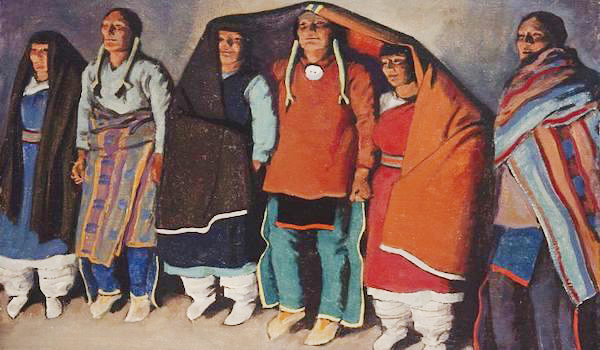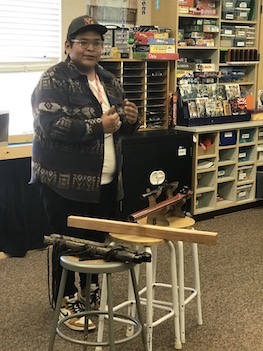SUBJECTS
GRADE
Show Results
Native American Round Dance

Lesson Summary
- Explore the traditional Native American Round Dance.
- Invite a Native American to share proper Round Dance steps.
- Compare and contrast beats of various Round Dance songs.
Lesson Plan and Procedure
Lesson Key Facts
- Grade(s): K, 1, 2, 3, 4, 5, 6, 7, 8, 9, 10, 11, 12
- Subject(s): Dance, Music, Social Studies, Native American
- Duration of lesson: 45 minutes
- Author(s): Chris Roberts and Brenda Beyal
Preparation
The Indigenous tribes/nations of Utah ask that teachers reach out to Native Americans within the community for assistance in teaching the Round Dance. Contacting families within your school community would be ideal. If other avenues are needed, contact your district Title VI coordinator or Indian education department within your state education system.
Title VI coordinators in Utah:
https://schools.utah.gov/eseastateinitiatives/_esea_state_initiatives_/_americanindian_/_overview_/TitleVICoordinators2024.pdf
Utah State Board of Education:
https://schools.utah.gov/eseastateinitiatives/americanindian 
It is important that you take the time to ask for help with this activity. Many tribal members are happy to come into schools and share their culture. Keeping the Round Dance as authentic and accurate as possible is just a way of being respectful and culturally sensitive, and it shows your understanding and awareness of cultural ways.
If at all possible, attend an event such as a Pow Wow or celebration where you can experience firsthand the Round Dance in its most authentic form. You will come away with an experience that will only enhance your teaching.
Background
The Native American Round Dance, also known as the “Circle of Friendship” dance, is universal to Native American tribes on the North American continent. Though songs are unique to each tribe, the drum is the primary connecting instrument between tribes. It is often described as the “heartbeat.” The Round Dance is a social dance that invites all to participate. There are many variations of the dance, so it can be enjoyed by all. It is a time to renew friendships, make new friends, accept differences, and celebrate the human connection.
Round-Dance videos:
https://www.youtube.com/watch?v=bwDYCAOXcQQ
https://www.youtube.com/watch?v=626MhRl6aFQ
Introduction
Give background information to students about the Round Dance. Have students listen to several different Round-Dance songs. Instruct them to listen for the beat of each song. Point out that some have a hard beat (stressed) and a soft beat (unstressed), while others have a steady hard beat. Have students compare and contrast as they listen to the variations of Round-Dance songs.
The Shoshone called the Round Dance a “circle dance.” The following example is sung by Bryan Hudson. In his own words, “This is a traditional Shoshone circle dance song that references the way the night stars look. I learned this song from the late Liz Brady of Elko, NV.”
https://soundcloud.com/newe-hupia/night-star-a-shoshone-circle-dance-song
The Paiute, like the Shoshone, sing circle-dance songs. This song is sung by Mark Rogers, a member of the Shivwits Band of the Paiute Tribe of Utah.
https://www.youtube.com/watch?v=vEe4N5jEKs4
The Navajo welcome all present who would like to participate in the Round Dance. Traditionally two circles are formed, with the men in the outside circle and the women in the inside circle. Arms are locked and the dancers move first in a clockwise direction and then in an opposite direction when a new song starts. The dance can also be danced in a universal circle, with all participating. Play “4. Navajo Love Song.”
https://www.youtube.com/watch?v=xNRm0lFKT-c
This song is a Plains Indian Round-Dance song. It is part of any Pow Wow, and all are invited to participate. It promotes cultural unity and provides a break in between contest dancing.
https://www.youtube.com/watch?v=qqqWy_CZ_5U
Round Dance
Introduce the guest and thank him or her for coming to your classroom. Give the guest the opportunity to share his or her name, tribe, and background. Hold a “Question and Answer” time. Invite your guest to teach the Round Dance. Allow the guest to use his or her own music or begin the music for the Plains Indian Round-Dance song shared previously.
Following are the steps that are generally used in the Round Dance.
Participants stand in a circle. Round Dances usually begin in a clockwise direction. Dancers get into ready position by bending their knees slightly, in a relaxed manner.
 The dance begins by pushing off with the right foot and taking one step left with the left foot on the beat and then taking a step to the left. On the next beat, bring the right foot next to the left.
The dance begins by pushing off with the right foot and taking one step left with the left foot on the beat and then taking a step to the left. On the next beat, bring the right foot next to the left.
When students are able to do this step with the music, have them hold hands and go in a clockwise direction and do the step.
The next step would be to incorporate arm movements. Have participants swing their arms in a forward position as they step left on the beat. On the next beat, students swing their arms in a backward position as they touch their right foot to their left.
Continue until the song is over.
Variations
- Have one person break off from the circle and lead the group around the room.
- Have one person break off and coil the group up like a snake and then uncoil it.
- As students pass in front of one another, they look at each other and give a greeting to enjoy the camaraderie of the Round Dance.
- Do the step using songs from different tribes.
Learning Objectives
- Explore the Round Dance, its movements and variations.
- Contrast various Round-Dance songs from different tribes.
- Learn the Round Dance from a guest invited to share his or her Native American culture.
Utah State Board of Education Standards
This lesson can be used to meet standards in many grades and subject areas. We will highlight one grade’s standards to give an example of application.
Grade 4 Dance
Standard 4.D.P.9: Use performance etiquette and performance practices during class, rehearsal, and in formal and informal performance spaces.
Standard 4.D.CO.4: Select and describe movements in a specific genre or style, and explain how the movements relate to the culture, society, historical period, or community from which the dance originated.
Grade 4 Music
Standard 4.M.R.1: Listen to and interact with a variety of contrasting music.
Standard 4.M.CO.3: Experience and explore music which connects us to history, culture, heritage, and community, and identify connections between a music genre and cultural or historical contexts.
Grade 4 Social Studies
Standard 4.3.1: Use primary sources to compare experiences of at least three groups’ migration to Utah between 1847–1896 (for example, members of The Church of Jesus Christ of Latter-day Saints, people from Greece, Italy, China).
Standard 4.5.6: Choose one of Utah’s cultural institutions and explain its historical significance as well as the cultural benefits to Utah families and our nation today.
Equipment and Materials Needed
- Drum
- Computer to play music selections
- Round-Dance videos:
- Music tracks:
Additional Resources
This lesson was created thanks to a grant from the National Endowment for the Arts and the Utah Division of Arts & Museums.
- The Round Dance explained: http://www.wisdomoftheelders.org/arlie-neskahi-2/
- Native American Round-Dance music: https://canyonrecords.bandcamp.com/album/best-round-dance-songs
- Video of a variation step of the Round Dance
- https://www.youtube.com/watch?v=NrOxSLedDbA
Image References
Image 1: Round Dance by Maynard Dixon, 1931, oil on canvas-board.
https://commons.wikimedia.org/wiki/File:Round_Dance_by_Maynard_Dixon,_1931.jpg
Image 2: Brenda Beyal.
Image 3: James Huston.

www.education.byu.edu/arts/lessons
 Download
Download